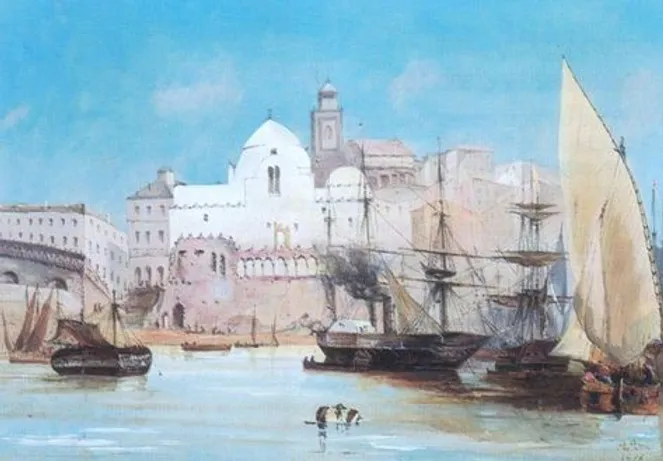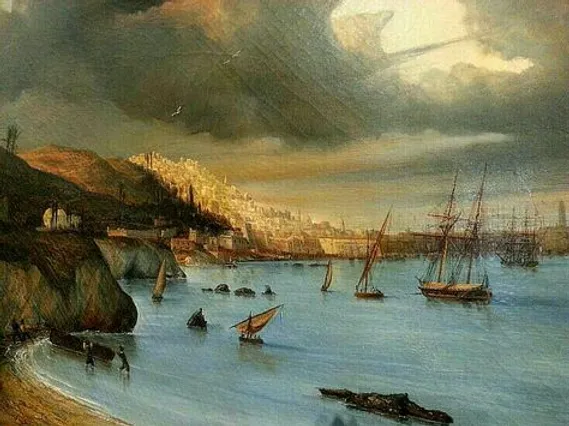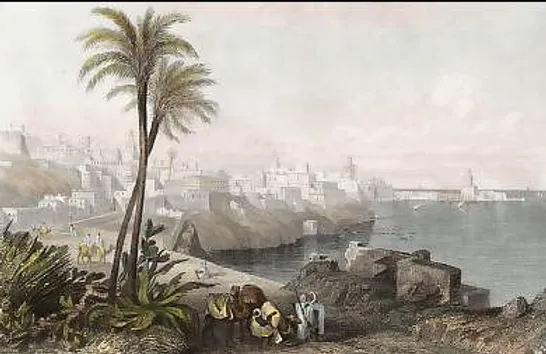The setting for The Muhammad Amalfi Mysteries is Algiers in the final decades of the Ottoman Regency. Like Camus who yearned for a future in which the city he loved might become a Utopian, impossible City of Man, my protagonist’s dream is of an Algiers that is the Amsterdam of the Mediterranean, a diverse hub where trade and ideas might flow freely in an idyllic, seaside setting of peaceful industry and international harmony.
In doing so, he may have had Andrew Marvell’s verses in mind:
Hence Amsterdam, Turk, Christian, pagan, Jew.
Staple of sects and mint of schism grew.
That bank of conscience where not one so strange
Opinion but finds credit and exchange.
All of that is a subject for a later post. Right now, let’s get a feeling for first impressions. All of these, other than that of Leo Africanus, are the impressions of Europeans writing in English. I imagine there are far more in French. ًًًًًًWho knows how many there might be in Arabic and, perhaps, in Turkish. I’ve not found any in Arabic. But I’ve collected passages from a variety of writers and traveler, mostly English, but some in translation. I’ve also found a number of paintings and drawings of the city as it appeared before the French incursions.
“On approaching Algiers from the sea, it presents the appearance of a town tranquilly and lazily reposing along the slope of a hill, surrounded by a fresh and verdant country.”
Algeria, The Topography and History, John Morrel, (London: Nathaniel Cooke, 1854) p.78
“The City has a triangular form, and is situated on the amphitheatrical slope of a hill, rising 372 feet above the sea, which washes its foot.”
The Tricolor on the Atlas: Algeria and the French Conquest, by Francis Pulszuky, Esq. (London: T. Nelson and Sons, 1854) p. 9

“The city is white and on a hill,” Commandant Guizot said. “All of the Moorish houses are whitewashed, and only a few of the newer buildings have windows which face on the street. As we approach from the sea it looks like a gigantic marble quarry. An extraordinary sight, I assure you.”

“It is a large town, containing families to the number of four thousand, and is environed with most stately and impregnable walls. The buildings thereof are very artificial and sumptuous; and every trade and occupation hath here a several place. Inns, bath-stoves, and temples here are very beautiful; the stateliest temple of all standeth upon the sea shore. Next unto the sea there is a most pleasant walk upon that part of the town wall, which the waves of the sea beat upon.”
The History and Description of Africa and of the Notable Things Therein Contained, by Leo Africanus (London: Hakluyt Society, 1846) Vol. II, p. 682

It is situated upon the declivity of a hill that faces the N. and N. E. whereby the houses rise so gradually above each other that there is scarce one but what, in one or other of those directions, has a full prospect of the sea. The Casbah, or citadel, built upon the highest part of the city towards the S. W. is of an octagonal figure, each of the sides in view having port-holes or embrasures defended with cannon.
Travels or Observations relating to Several Parts of Barbary, by Thomas Shaw, Vol. 1, p.84
“…The houses are all high, and so close together, there being no room for gardens, that there is nothing to soften the glaring whiteness of the town, which has, in consequence, been frequently compared to a chalk pit… But the surrounding country is so extremely beautiful that I know not in what terms to describe it. Such variety of ground, such woods and dells, such lawns and verdure, prettily situated villas and gardens, so much cultivation in every direction, contrasting forcibly with the white town, present themselves in one large amphitheater as you look from the sea. Towards the eastern side of the Bight where the small river Harratch flows into the sea, the beach is low and sandy, but rises again immediately, and the eye is carried on to the snowy peaks of Mount Atlas, which make an admirable distance to this magnificent foreground.”
Extracts from the Journals of Lord Grosvenor Being an Account of His Visit to The Barbary Regencies in the Spring of 1830 (London: G. Harding, N.D.)
But the interest of everyone [on board] is now centered on a low dark line of coast, with a background of mountains, which every minute becomes more defined; and we watch it until we can discern one or two of the highest peaks, tipped with snow. Soon we can make out a bright green, or rather as it seems in the sunlight, a golden shore, set with a single gem that sparkles in the water. Again it changes into the aspect of a little white pyramid or triangle of chalk on a green shore shelving into the sea, next to an irregular mass of houses with flat roofs, and mosques with ornamented towers and cupolas, surrounded and surmounted by grim fortifications.
Artists and Arabs or Sketching in Sunshine, by Henry Blackburn (London: Sampson Low, Son, and Marston, 1868)
“The town of Algiers, on approaching it from the north, looks at a distance as if it stood on a kind of platform let down from a high range of hills behind.”
Four Months in Algeria: with A Visit to Carthage, Rev. Joseph Blakesley (Cambridge: Macmillan and Co., 1859) p.

As the vessel glides into the still waters of the port, Algiers, the Algiers of many a thrilling and romantic story, lies before him, vague, shadowy, and mysterious, with the curtain of night yet undrawn from her sleeping face. …He looks about him in the luminous darkness, luminous as all Algerian nights are, with tender shades of blue on sea and sky, and his first impression is that he has chanced upon some gala night. …Then is the moment, when the rose-glow lights her white-washed walls with a magic beauty, for the traveller to take his first real look at Algiers—the warlike, the white—as she rises blushing from the sea….Imagine terrace after terrace of pure white marble piled upon a sunny height, with a broad blue bay below; bright green hills stretching towards a vast velvety plain on either side; beyond all a line of snow-tipped mountains and distant as clouds, and you have some shadowy idea of as fair a picture as the world can show. Walks in Algiers and its Surroundings, by L. G. Seguin (London: Daldy, Isbister and Co., 1878)

“When the sun rises full upon her, painting her with those vermillion tints which every morning reach her strait from Mecca, one might fancy her to have risen during the night from an enormous block of pure white marble veined with rose-color.” One Année dans le Sahel, Fromentin
Algiers, forming an extensive semicircle of hills rising in amphitheatric beauty round the city, and many of them studded with country houses, is exceedingly picturesque as seen from the sea, while the numerous vineyards, orange and olive groves which surround the town, showing marks industry and cultivation, do not bear much analogy to the fierce character and vagrant lives of these African tyrants.
Narration of a Residence in Algiers, 1814, Pananti,

The town has the appearance of a theatre, the houses rising in tiers one slightly raised above the other. Its form is quadrilateral, the buildings closely pressed together without gardens.
Voyages de M. de Breve, 1605
Algiers looks from the sea like the sail of a great ship (Peysonnell, 1725)
Standing here, there stretches below us what is at once, perhaps, the brightest and yet the saddest part of Algiers—the harbor, with its surrounding buildings. …every inch we tread on has been trodden before us by countless suffering mortals, many of them our own fellow countrymen. Who, think you, carved those exquisite renaissance wreath of pendant fruits which smile at us from many a door lintel, in curious contrast to the Arabian architecture around them? Christian slaves. Who, when Khair-ed-Din succeeded in ousting the Spaniards from the Penon, built on it that shapely lighthouse tower, with its white walls outlined by bands of bright tiles? Christian slaves again. Who constructed the jetty that connects it with the mainland? Twenty thousand Christian slaves. Who lived in that beautiful old house with its Moorish fountain and Arabic inscriptions carved on white marble? Cruel Turkish taskmasters, who looked well to it that the lashes were not spared.
A Land of Mosques and Marabouts: History and Present Condition of the Barbary States, Michael Russell ( 1835) pp.316-319

Excellent description of the city’s defenses…
a fortified sea front about a mile long protected the town, in which stood a strong citadel. In front of the town, just offshore, lay a heavily fortified island attached to the waterfront by a breakwater in the harbor, which was only open to the south. At the point at which the breakwater joined the island sat the so-called lighthouse battery, containing three tiers of guns extending as far as the mouth of the harbor. Protecting this on the landward side was the fish-market battery, supplemented by two other batteries, one to the north, the other to the south. In the harbor itself lay a varying number of warships which could assist in the defense of the city. Not counting the guns mounted in these vessels, Algiers had about a thousand cannon facing seawards, supported by a large, though indeterminate, garrison, backed by tens of thousands of auxiliaries who could be brought in from the surrounding countryside. Whatever the quality of their gunners, the Algerines could almost certainly replace their losses with relative ease, and they had an ample stock of powder in reserve. Thus, with permanent stone-built fortifications mounting a profusion of heavy ordnance, the defenses of Algiers were formidable indeed.
Fremont-Barnes, Gregory. The Wars of the Barbary Pirates (Guide to…) . Bloomsbury Publishing. Kindle Edition.


